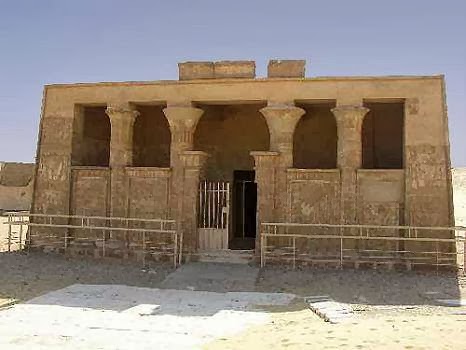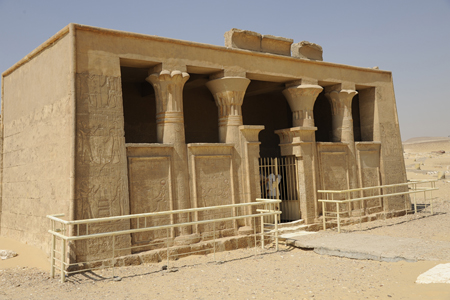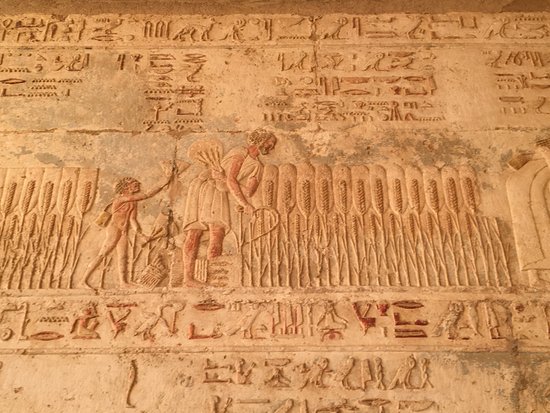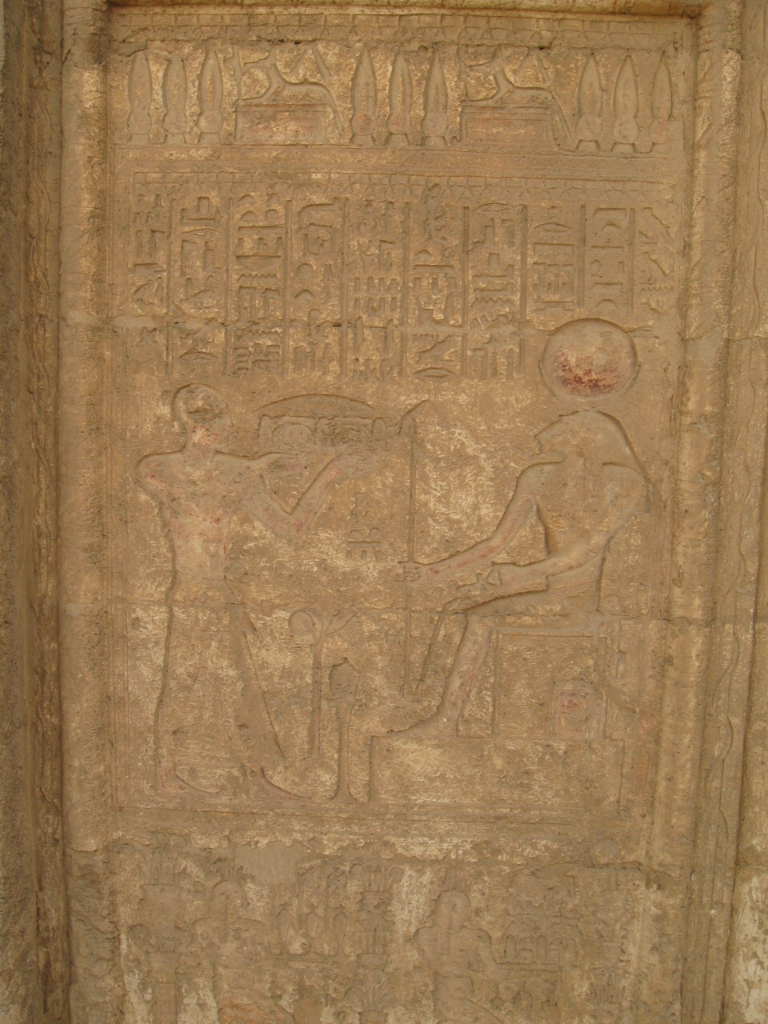
Petosiris, whose name is P- di-wsir (or the Gift of Osiris), was 'High Priest' of Thoth. He built a tomb for himself, his father Shesu, his brother Djed-thoth-iw-f-ankh, and his son Zeho. Thus, three generations were buried in his tomb. The tomb of Petosiris is the only free-standing tomb that takes the shape of the façade of the Egyptian temple that dates back to the early Greco-Roman Period, to the reign of Ptolemy I. The tomb of Petosiris is built from both limestone and sandstone and takes a rectangular shape. Measuring 6 m in width and 7 m in length, it consists of a pronaos and a naos. The tomb of Petosiris is famous for its mixed iconography which only appeared in the pronaos where the daily life scenes are represented. It best appears in the light of blue color which is a Greek color that appeared for the first time in that tomb. The deceased and his workers all appeared in frontal view. The male and female figures are all dressed in Greek tunics and with curly hair.
The Façade of the Tomb of Petosiris

Worth admiration in the area befor Petosiris Tomb is the high horned stone altar. The façade of the tomb consists of four columns attached to one another by means of screen walls. The two columns on the sides have palm leaves capitals while the two in the middle have composite floral ones. On either side of the entrance is the speech of Petosiris addressed to the visitors of the tomb asking them to make offerings to him in the form of one thousand of bear, one thousand of wine, one thousand of oxen and one thousand of fowls. As for the screen walls, they are also decorated with various scenes and inscriptions. The first two screen walls on either side of the entrance doorway are decorated by the autobiography of Petosiris and his family members. The two screen walls in the middle are decorated with a scene of Petosiris in front of god Thoth in his Ibis form. The two outer screen walls are decorated by a similar scene of Petosiris but in front of Thoth in the form of a baboon. As for the pilaster on the extreme outer sides, it is divided into three registers, depicting Petosiris in front of different deities. The bottom register, in the right side, shows him standing before Nephthys; the middle one in front of Osiris; and the uppermost one in front of Sokar. As for the left side, the lower register represents him before Isis; the middle one before Osiris; and the uppermost one in front of an unidentified deity (as his head is damaged).
The Pronaos of Tomb of Petosiris

The entrance of the Tomb of Petosiris leads to the pronaos, a rectangular hall with walls vividly decorated with scenes of daily life showing the mix iconography. The following are scenes depicted on walls. Beginning from the left side, are captured: - Two men seated on either side of a heap of berries from which they are removing the bad ones. And a third man is shown empting a sack of berries into the heap. Lower down, the scene shows two methods of crushing the berries to extract oil. - Carpenters making funerary furniture and goldsmiths melting the gold to make jewelry. - Some depictions of agricultural scenes: the lower register shows workers plowing the land, and throwing the seeds; the middle register shows harvesting the flax and collecting it in bundles; and the top scene shows harvesting and threshing the wheat. - On the sides of the entrance to the naos, are depicted Petosiris, his wife and members of their family. On the top and middle registers, there are scenes of cattle breeding. In one of the scenes, an ox is mating with a cow, which gives birth to a calf. Another scene shows a man sitting underneath a cow and milking it. The lower register represents the gathering of grapes and the making of wine. - At the back of the screen walls, on the right hand side, there are scenes of hammering metal to make offering tables and game pieces. And another scene shows the weighing of a metal jar. - At the interior side of the pilaster, Petosiris is shown playing the Senet game. The pronaos gives access to the naos of Petosiris by means of a doorway whose sides are decorated with lines of Hieroglyphic inscriptions giving the detailed autobiography of Petosiris.
Naos of Petosiris Tomb

The naos is a rectangular hall that contains four pillars supporting its roof. At the middle of the hall, there is a burial shaft which measures about 8 m in depth. At the bottom of the shaft, there is a burial chamber that houses the mummies of Petosiris, his father, his brother and his son, who were all High Priests of Thoth. The naos' walls are all decorated with funerary and religious scenes, all following the ancient Egyptian artistic style. The scenes on the left part of the naos represent Shesu, the father of Petosiris and the High Priest of Thoth. The sides of the pillars are all decorated with scenes of the deceased in front of different deities. From the left side, the scenes depict: - Shesu and his wife in front of a sacred tree from which emerges goddess Nut. - The transportation of the funerary equipments of Shesu to his tomb, including a naos being brought on a cart rather than on sledges in the usual way. - Shesu as a mummy standing on the staircase of his tomb and in front of him is his grandson Zeho wearing panther skin and purifying the mummy of his grandfather. - Oxen are shown slaughtered under Shesu's feet and nine squares of geniis all are raising their arms in adoration in front of a representation of Shesu on a large scale. - God Hepri of eternity, in the form of a scarab wearing the Atef Crown and flanked by Nekhbet and Wadjet, as female figures with the heads of a vulture and cobra. - A line of deities in front of god Thoth - Nine baboons represented as worshipers of the sun and the erection of the Ded Pillar, symbol of resurrection.
